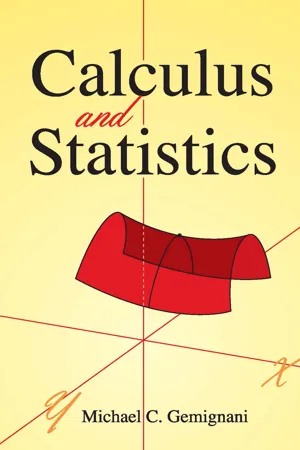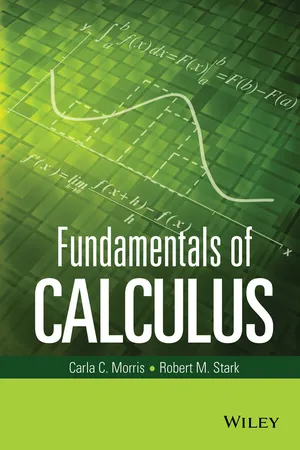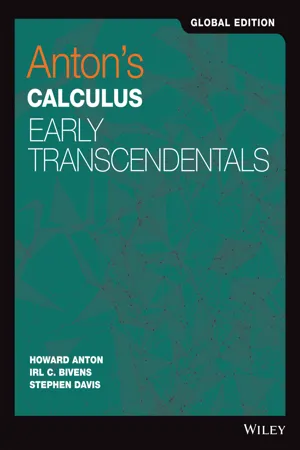Mathematics
Finding Maxima and Minima Using Derivatives
Finding maxima and minima using derivatives involves using the first and second derivative tests to determine the critical points of a function and classify them as maxima, minima, or points of inflection. The first derivative test examines the sign changes around critical points, while the second derivative test analyzes concavity to confirm the nature of the extremum.
Written by Perlego with AI-assistance
Related key terms
1 of 5
6 Key excerpts on "Finding Maxima and Minima Using Derivatives"
- eBook - ePub
- Michael C. Gemignani(Author)
- 2014(Publication Date)
- Dover Publications(Publisher)
Applications of the Derivative5.1 MAXIMA AND MINIMA Thus far we have been concerned primarily with the computation of derivatives; we now put derivatives to use. First, however, some words of caution are in order.First, it should be evident that we can gain information from the derivative of a function only where the function has a derivative. There are, however, perfectly decent functions (see, for instance, Example 14 of Chapter 4 ) which do not have derivatives at certain points. The absence of a derivative at a point may itself give us certain information about the function being investigated; but if a function does not have a derivative at a point, then the differential calculus will be a poor tool to investigate the behavior of the function at that point.Second, we shall often be concerned with functions whose values we wish to consider only for a restricted portion of the real numbers. For example, if X is a random variable and F is the distribution function of X, then we might consider F(x) only for admissible values of X. Quite often the formal definition of a function, for example, f(x) = x2 , will “make sense” even for values of x other than those to which we may restrict ourselves. When a value of x is found to have a formal property that we are interested in, we must be certain that that value of x lies in the subset of the real numbers that is of interest to us.In this section we shall consider maxima and minima. In the context of this section, the admonitions above may be made concrete as follows:1) When trying to find the maxima and minima of a function, we must take into account those points at which the function does not have a first derivative, as well as those points at which the function is differentiable; and2) we will be interested only in those maxima and minima which occur for admissible values of the function variable.Definition 1. Let f be a function from T into R. The function f is said to have an absolute minimum - eBook - ePub
- Carla C. Morris, Robert M. Stark(Authors)
- 2015(Publication Date)
- Wiley(Publisher)
Such situations arise in a multitude of practical instances – natural and otherwise. Optimization Derivatives aid curve sketching and help to locate optima. Local (or relative) maxima and minima imply optima in a region about the point in question. Absolute maxima and minima refer to the largest and smallest, respectively, in the entire domain – not necessarily at horizontal tangents. A series of examples follow. Example 3.4.1 Maximum Value of a Product Find the maximum value of the product of two numbers whose sum is 10. Solution: Let x and represent the numbers. Their product is the quadratic:, Now, setting the derivative to zero gives and, therefore,. Notice that when, the derivative is positive, and when, the derivative is negative. Therefore, there is a maximum about. If, then is also 5. The desired numbers are both equal to 5! The maximum value of their product is. (You may remember a “rule of thumb” from a pre-calculus course. The maximum of the product of two positive numbers, whose sum is fixed, occurs when they are equal). Quadratics have many applications as in the previous example and the following one. Example 3.4.2 Maximum Garden Area What is the maximum possible area of a rectangular garden using 40 feet of fencing? Solution:. Let x and y represent the sides. The perimeter, P, is, and the area is. We seek to maximize xy subject to the perimeter constraint. An immediate obstacle is the appearance of two variables. However, use the constraint to express one of them in terms of the other. To express area, A, in terms of a single variable, say x, replace y by 20 − x. The area, expressed as a function of a single variable, becomes ↓ We have replaced A by A(x) simply to signal it is now a function of a single variable, x. The derivative is set to zero to yield a critical point at. As the derivative changes sign (positive when and negative when), there is a maximum at - Ronald Harshbarger, James J. Reynolds(Authors)
- 2018(Publication Date)
- Cengage Learning EMEA(Publisher)
Martin Charles Hatch/Shutterstock 627 A P P L I C AT I O N S Advertising, aging workers Water purity, profit, diminishing returns Maximizing revenue, minimizing average cost, maximizing profit Company growth, minimizing cost, postal restriction, inventory-cost models, property development Production costs S E C T I O N S CHAPTER WARM-UP 10.1 Relative Maxima and Minima: Curve Sketching 10.2 Concavity: Points of Inflection Second-derivative test 10.3 Optimization in Business and Economics Maximizing revenue Minimizing average cost Maximizing profit 10.4 Applications of Maxima and Minima 10.5 Rational Functions: More Curve Sketching Asymptotes More curve sketching T he derivative can be used to determine where a func- tion has a “turning point” on its graph so that we can determine where the graph reaches its highest or lowest point within a particular interval. These points are called the relative maxima and relative minima, respectively, and are useful in sketching the graph of the function. The techniques for finding these points are also useful in solving applied problems such as finding the maximum profit, the minimum average cost, and the maximum productivity. The second derivative can be used to find points of inflection of the graph of a function and to find the point of diminishing returns in certain applications. The topics and some representative applications dis- cussed in this chapter include the following. Applications of Derivatives 10 Copyright 2019 Cengage Learning. All Rights Reserved. May not be copied, scanned, or duplicated, in whole or in part. Due to electronic rights, some third party content may be suppressed from the eBook and/or eChapter(s). Editorial review has deemed that any suppressed content does not materially affect the overall learning experience. Cengage Learning reserves the right to remove additional content at any time if subsequent rights restrictions require it.- eBook - PDF
Anton's Calculus
Early Transcendentals
- Howard Anton, Irl C. Bivens, Stephen Davis(Authors)
- 2018(Publication Date)
- Wiley(Publisher)
172 4 In this chapter we will study various applications of the derivative. For example, we will use methods of calculus to analyze functions and their graphs. In the process, we will show how calculus and graphing utilities, working together, can provide most of the important information about the behavior of functions. Another important application of the derivative will be in the solution of optimization problems. For example, if time is the main consideration in a problem, we might be interested in finding the quickest way to perform a task, and if cost is the main consideration, we might be interested in finding the least expensive way to perform a task. Mathematically, optimization problems can be reduced to finding the largest or smallest value of a function on some interval, and determining where the largest or smallest value occurs. Using the derivative, we will develop the mathematical tools necessary for solving such problems. We will also use the derivative to study the motion of a particle moving along a line, and we will show how the derivative can help us to approximate solutions of equations. THE DERIVATIVE IN GRAPHING AND APPLICATIONS 4.1 ANALYSIS OF FUNCTIONS I: INCREASE, DECREASE, AND CONCAVITY Although graphing utilities are useful for determining the general shape of a graph, many problems require more precision than graphing utilities are capable of producing. The purpose of this section is to develop mathematical tools that can be used to determine the exact shape of a graph and the precise locations of its key features. INCREASING AND DECREASING FUNCTIONS The terms increasing, decreasing, and constant are used to describe the behavior of a func- tion as we travel left to right along its graph. For example, the function graphed in Fig- ure 4.1.1 can be described as increasing to the left of x = 0, decreasing from x = 0 to x = 2, increasing from x = 2 to x = 4, and constant to the right of x = 4. - eBook - PDF
Calculus
Single Variable
- Howard Anton, Irl C. Bivens, Stephen Davis(Authors)
- 2016(Publication Date)
- Wiley(Publisher)
50. The accompanying figure shows a computer-generated graph of the polynomial y = 0.1x 5 (x + 1) 2 using a viewing 3.4 Absolute Maxima and Minima 157 window of [−2, 1.5] × [−0.2, 0.2]. Show that the choice of the vertical scale caused the computer to miss important features of the graph. Find the features that were missed and make your own sketch of the graph that shows the miss- ing features. Figure Ex-49 Figure Ex-50 51. Writing Suppose that x = x 0 is a point at which a function f is continuous but not differentiable and that f (x) ap- proaches different finite limits as x approaches x 0 from ei- ther side. Invent your own term to describe the graph of f at such a point and discuss the appropriateness of your term. 52. Writing Suppose that the graph of a function f is obtained using a graphing utility. Discuss the information that cal- culus techniques can provide about f to add to what can al- ready be inferred about f from the graph as shown on your utility’s display. QUICK CHECK ANSWERS 3.3 1. (a) (−1, 0), (3, 0), ( 0, 9 8 ) (b) x = −2 and x = 4 (c) y = 3 (d) (−∞, −2), (−1, 3), and (4, +∞) (e) (−∞, −2) and (−2, 1] (f ) (−∞, −2) and (4, +∞) (g) ( 1, 4 3 ) 2. (a) (−2, 0), (2, 0) (b) x = 0 (c) y = 0 (d) (−∞, −2) and (2, +∞) (e) (−∞, −4] and (0, 4] (f ) (−∞, −4 11/5) and (4 11/5, +∞) (g) ±4 11/5 ≈ ±5.93 3.4 ABSOLUTE MAXIMA AND MINIMA At the beginning of Section 3.2 we observed that if the graph of a function f is viewed as a two-dimensional mountain range (Figure 3.2.1), then the relative maxima and minima correspond to the tops of the hills and the bottoms of the valleys; that is, they are the high and low points in their immediate vicinity. In this section we will be concerned with the more encompassing problem of finding the highest and lowest points over the entire mountain range, that is, we will be looking for the top of the highest hill and the bottom of the deepest valley. - eBook - PDF
- Stefan Waner, Steven Costenoble(Authors)
- 2017(Publication Date)
- Cengage Learning EMEA(Publisher)
97. ▼ Explain geometrically why the derivative of a function has a relative extremum at a point of inflection, if it is defined there. Which points of inflection give rise to relative maxima in the derivative? 98. ▼ If we regard position, s, as a function of time, t, what is the significance of the third derivative, s t 1 t 2 ? Describe an everyday scenario in which this arises. 47 The model is the authors’ and is based on data in Environmental and Natural Resource Economics by Tom Tietenberg, third edition (New York: HarperCollins, 1992), p. 282. Copyright 2018 Cengage Learning. All Rights Reserved. May not be copied, scanned, or duplicated, in whole or in part. WCN 02-300 5.4 Analyzing Graphs 433 5.4 Analyzing Graphs Mathematical curves are beautiful—their subtle form can be imitated by only the best of artists—and calculus gives us the tools we need to probe their secrets. While it is easy to use graphing technology to draw a graph, we must use calculus to under- stand what we are seeing. Following is a list of some of the most interesting features of the graph of a function. Features of a Graph 1. The x- and y-intercepts: If y 5 f 1 x 2 , find the x-intercept(s) by setting y 5 0 and solving for x; find the y-intercept by setting x 5 0 and solving for y: y x 2. Extrema: Use the techniques of Section 5.1 to locate the maxima and minima: y x 3. Points of inflection: Use the techniques of Section 5.2 to locate the points of inflection: y x 4. Behavior near singular points of f : ✱ If a is a singular point of f , con- sider lim x Sa 2 f 1 x 2 and lim x Sa 1 f 1 x 2 to see how the graph of f behaves as x approaches a: y x ✱ Recall from Section 3.2 that a is a singular point of f if f 1 a 2 is not defined, but f 1 x 2 is defined for (at least some) points arbitrarily close to and on both sides of a. Copyright 2018 Cengage Learning. All Rights Reserved. May not be copied, scanned, or duplicated, in whole or in part. WCN 02-300
Index pages curate the most relevant extracts from our library of academic textbooks. They’ve been created using an in-house natural language model (NLM), each adding context and meaning to key research topics.





